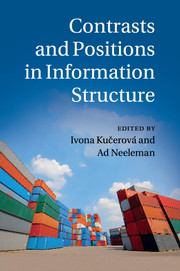Book contents
- Frontmatter
- Contents
- List of Contributors
- 1 Introduction
- Part I The architecture of grammar and the primitives of information structure
- Part II Exploring the interfaces: case studies
- 8 NP ellipsis without focus movement/projections: the role of Classifiers
- 9 Focus in Greek wh-questions
- 10 Against FocusP: arguments from Zulu
- 11 Scrambling as formal movement
- 12 Left-peripheral arguments and discourse interface strategies in Yucatec Maya
- Bibliography
- Index
12 - Left-peripheral arguments and discourse interface strategies in Yucatec Maya
from Part II - Exploring the interfaces: case studies
Published online by Cambridge University Press: 05 August 2012
- Frontmatter
- Contents
- List of Contributors
- 1 Introduction
- Part I The architecture of grammar and the primitives of information structure
- Part II Exploring the interfaces: case studies
- 8 NP ellipsis without focus movement/projections: the role of Classifiers
- 9 Focus in Greek wh-questions
- 10 Against FocusP: arguments from Zulu
- 11 Scrambling as formal movement
- 12 Left-peripheral arguments and discourse interface strategies in Yucatec Maya
- Bibliography
- Index
Summary
Preliminaries
Theoretical considerations
It has been observed for several languages that constituents in the left periphery bear particular information-structural functions such as ‘topic’ and ‘focus’. On the basis of this observation, some accounts assume that these constituents occupy the Specifier positions of functional projections such as TopP (topic phrase) and FocP (focus phrase) that are dedicated to particular information-structural functions (see Rizzi 1997; É. Kiss 1998; among others). This view is summarized in (1).
Discourse configurational hypothesis The information-structural properties of constituents in the left periphery result from the fact that particular structural configurations are associated with information-structural concepts.
Recent literature on information structure challenges the isomorphic view of constituent structure and information structure in (1). Proponents of the ‘discourse underspecification hypothesis’ claim that the alleged association is the epiphenomenal result of interface strategies that relate to properties of the linearization and/or the prosodic structure and conclude that reflexes of information structure do not arise from formal features that are inherent in the left-peripheral positions, as outlined in (2) (see Wedgwood 2003; Fanselow 2006; Hartmann and Zimmermann 2006; Zimmermann 2008; Fanselow and Lenertová in press).
Discourse underspecification hypothesis The information-structural properties of constituents in the left periphery result from interface strategies that relate to properties of the linearization and the prosodic structure.
The two hypotheses make different predictions with respect to the systematic occurrence of information-structural properties with particular structural configurations. In terms of the discourse configurational hypothesis, a formal feature F is associated with the head of a functional projection. When a constituent in the numeration bears the same feature F, e.g. <focus>, then it undergoes a syntactic operation that leads the feature-bearing constituent to the position that allows the matching of the feature at issue with the corresponding functional Head, e.g., the Specifier of the FocP. The empirical consequence of this view is that only those constituents that bear exactly the feature F are expected to occur in the position at issue, hence the possibility of constituents that do not bear the critical feature F undergoing the same syntactic operation is evidence against the fundamental assumptions of the discourse configurational hypothesis (in this vein, Wedgwood et al. unpub. ms. evaluate counterexamples in texts as evidence against the assumption of a FocP in Hungarian).
Information
- Type
- Chapter
- Information
- Contrasts and Positions in Information Structure , pp. 296 - 321Publisher: Cambridge University PressPrint publication year: 2012
Accessibility standard: Unknown
- 4
- Cited by
